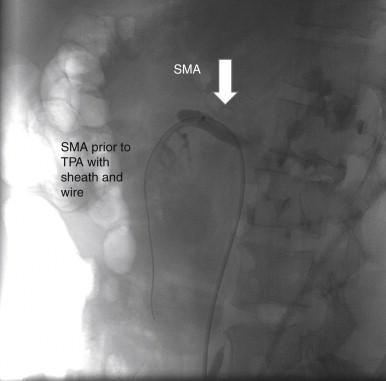Physical Address
304 North Cardinal St.
Dorchester Center, MA 02124
Embolism and thrombosis of the mesenteric arteries, mesenteric venous thrombosis, and nonocclusive mesenteric ischemia are the four major causes of acute intestinal ischemia. Mortality rates for patients with acute mesenteric arterial occlusion range between 50% and 90%, and the presence and extent of bowel infarction predict mortality. A successful outcome depends on prompt diagnosis, rapid resuscitation, and surgical or endovascular revascularization, intestinal resection, and judicious use of a second-look celiotomy.
Acute embolic occlusion of the superior mesenteric artery (SMA) produces a characteristic syndrome of abdominal pain in 75% to 90% of patients and is often accompanied by vomiting and gastrointestinal emptying ( Figure 1 ). A detailed history and physical examination usually elicit several important features. Patients might have no antecedent symptoms of chronic mesenteric ischemia, but between 30% and 43% of patients present with acute embolic occlusions superimposed on chronic occlusive disease. Approximately 75% of patients have a history of an atrial tachyarrhythmia, 30% have a history of embolic events, and 20% have synchronous emboli in other arterial beds. Atrial fibrillation, myocardial infarction, left ventricular aneurysm, prosthetic heart valves, and rheumatic heart disease can lead to the formation of thrombus that serves as a source of peripheral emboli. The classic finding of pain out of proportion to physical examination occurs because visceral ischemic pain precedes the somatic pain that is associated with transmural ischemia and peritoneal irritation. Peritoneal signs and sepsis are late findings associated with increasing mortality rates.

Several studies now report that acute emboli account for 28% to 42% of acute mesenteric ischemia. The common occurrence of acute emboli to the SMA may be a result of the oblique origin of this artery from the aorta. Fifteen percent of emboli lodge at the ostium of the SMA, 50% lodge distal to the proximal jejunal and middle colic branches, and 35% fragment and embolize distally. Embolic obstruction of the SMA produces ischemia from the level of the proximal jejunum to the transverse colon. The colon’s splenic flexure is often affected because it receives the terminal blood supply of both the SMA and inferior mesenteric artery (IMA) circulation.
Become a Clinical Tree membership for Full access and enjoy Unlimited articles
If you are a member. Log in here